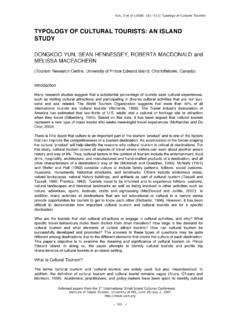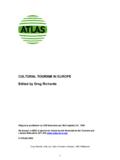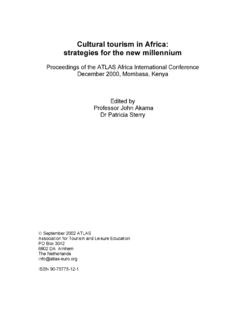Transcription of ECOTOURISM STATISTICAL FACT SHEET - Active …
1 ECOTOURISM STATISTICAL fact SheetThe International ECOTOURISM Society, 2000 ECOTOURISM STATISTICAL fact SHEETG eneral Tourism StatisticsWorldwideThe World Tourism Organization (WTO) estimates that there were more than 663 million internationaltravelers in 1999. Spending by these tourists was estimated at more than US$453 billion. Tourist arrivals arepredicted to grow by an average a year over the next two decades, surpassing a total of one billioninternational travelers by the year 2010 and reaching billion by the year 2020 (WTO, 2000). Tourism is theworld s largest employer, generating, directly and indirectly, nearly 200 million jobs or some 10% of the jobsglobally (Honey and Rome, 2000).
2 The ECOTOURISM MarketMarket PlacementEcotourism is a nature based form of specialty travel defined by The International ECOTOURISM Society (TIES)as responsible travel to natural areas which conserves the environment and sustains the well-being of localpeople. This definition has been widely accepted, but does not serve as a functional definition for gatheringstatistics. No global initiative presently exists for the gathering of ECOTOURISM data. ECOTOURISM should beconsidered a specialty segment of the larger nature tourism Size of the MarketCeballos-Lascur in (1993) reports a WTO estimate that nature tourism generates 7% of all international travelexpenditure (Lindberg, 1997).
3 The World Resources Institute (1990) found that while tourism overall has beengrowing at an annual rate of 4%, nature travel is increasing at an annual rate between 10% and 30% (Reingold,1993). Data which supports this growth rate is found in Lew s (1997) survey of tour operators in the Asia-Pacific region who have experienced annual growth rates of 10% to 25% in recent years (Lindberg, 1997).WTO (1998) stated that ECOTOURISM and all nature-related forms of tourism account for approximately 20percent of total international (1992) outlines the magnitude of the ECOTOURISM market through the use of general tourism qualifies ECOTOURISM as travel to enjoy and appreciate nature.
4 In the opinion of TIES this moreclosely represents nature tourism, and is identified as such on the table below. Fillion identified, through ananalysis of inbound tourist motivations to different worldwide destinations, that 40-60% of all internationaltourists are nature tourists and that 20-40% are wildlife-related tourists. (Different multipliers were used inthese figures.) Nature tourists can be defined as tourists visiting a destination to experience and enjoy nature,and wildlife-related visitors can be defined as tourists visiting a destination to observe wildlife ( bird-watchers).
5 Total International Tourism ArrivalsNature TouristsWildlife-related Tourists1988 - 393 million157-236 million79-157 million1994 - million211-317 million106-211 millionTotal International Direct Economic Impact *Nature TouristsWildlife-related Tourists1988 - US$388 billionUS$93-223 billionUS$47-155 billion1994 - US$416 billionUS$166-250 billionUS$83-166 billion* Total International Direct Economic Impact = money spent on travel by tourists traveling Market ProfileBased on data collected by a survey completed by HLA and ARA consulting firms of North American travelconsumers (1994), TIES has constructed the following ecotourist market :35 - 54 years old, although age varied with activity and other factors such as : ECOTOURISM STATISTICAL fact SheetThe International ECOTOURISM Society, 200050% female and 50% male, although clear differences by activity were :82% were college graduates, a shift in interest in ECOTOURISM from those who have high levelsof education to those with less education was also found, indicating an expansion into mainstream composition.
6 No major differences were found between general tourists and experienced composition**:A majority (60%) of experienced ECOTOURISM respondents stated they prefer to travel as a couple, with only15% stating they preferred to travel with their families, and 13% preferring to travel duration:The largest group of experienced ecotourists (50%) preferred trips lasting 8-14 :Experienced ecotourists were willing to spend more than general tourists, the largest group (26%) stating theywere prepared to spend $1,001-$1,500 per elements of trip:Experienced ecotourists top three responses were: (1) wilderness setting, (2) wildlife viewing, (3) for taking next trip:Experienced ecotourists top two responses were (1) enjoy scenery/nature, (2) new experiences/places.
7 ** Experienced ecotourists = Tourists that had been on at least one ECOTOURISM oriented trip. Ecotourismwas defined in this study as nature/adventure/culture oriented for ECOTOURISM DestinationsUSAD omestic and international travelers made nearly 287 million recreation visits to the 378 recreation areasadministered by the National Park Service (NPS) in 1998 compared to the 275 million visits in 1997 This isan increase of (Travel Industry Association of America, 2000).Travel to the United States National Parks Service areas generated direct and indirect economic impact for localcommunities of US$ billion and supported almost 300,000 tourist-related jobs during 1996.
8 It is unknownwhat portion of these visitors represented participation in ECOTOURISM activities (Tourism Works for America,1997).NepalThe Annapurna area is the most popular trekking destination in Nepal. Since 1989 the number of trekkerscoming to the area has increased at an annual rate of approximately 18%. In 1997, 50,708 international trekkersvisited the area. Out these 12,000 visited the Annapurna sanctuary (Gurung, no date).BelizeIn 1999 of tourists to Belize visited Mayan sites, visited Parks and reserves. Importantreasons for visiting Belize are: to observe scenic beauty, to be in a natural setting and to observe wildlife(Higgins, 2000).
9 Cayes and Barrier reefs were visited by 87% of visitors. 82% of visitors to Belize were in the agegroup of 18 to 50 years old and 65% were college graduates (Higgins, 2000)Galapagos IslandsGalapagos nature tourism has grown steadily since the pioneering days of the 1970 s, to the present level of over60,000 visitors a year, making a $100 million-plus contribution to the Ecuadorian economy (estimates vary)(Charles Darwin Research Station, 2001)KenyaFrom 1983 to 1993 visitor arrivals to Kenya grew by 45% (372,000 to 826,000). The Kenya Wildlife Service(1995) estimates that 80% of Kenya s tourist market is drawn by wildlife and that the tourism industry generatesEcotourism STATISTICAL fact SheetThe International ECOTOURISM Society, 2000one-third of the country s foreign exchange earnings.
10 Revenue from Kenya s wildlife parks increased to Ksh. 711million in 1995. (In 1997 US$1=60KS).AustraliaThere are an estimated 600 ECOTOURISM operators in Australia today, approximately 85% of these employ fewerthan 20 staff. ECOTOURISM businesses are estimated to have an annual turnover of some $250 million and toemploy a total staff of around 6500, the equivalent of 4500 full-time staff (Sport and Tourism DivisionAustralian government, 1999).There has been a considerable increase of international visitors to Australia s national parks, with a rise in visitornumbers between 1993 and 1996 form around million to more than million, an increase of per 1998, this figure had increased to nearly million, or 47% of all inbound visitors to Australia aged 15 andover reported having visited national parks (Bureau of Tourism Research, cited by Sport and Tourism DivisionAustralian government, 1999).




